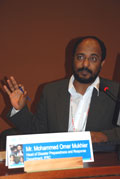
Women and girls in food and livelihood security
Women account for half of the world’s population and nearly 43 percent of the world’s farmers, although their contribution to the agricultural labour force can be much higher – more than 60 percent in some countries. Although cooking, fetching water and collecting firewood can occupy some part of their time; women are engaged in growing much of the world’s food and play a significant role at all the different stages of food production, processing and preparing. Women are key players in the farming sector, and hence actively engaged in the market economy. In Africa more than 50 percent of women work in agriculture. In North Africa a higher percentage of women work in agriculture than men. Women, in most societies, have the prime role in translating available food into nutrition security, particularly for young children.
While many national legal codes have incorporated provisions acknowledging gender equality in relation to access and ownership of land and other productive resources, women’s rights to own resources on equal conditions to those of men are in many countries repeatedly disregarded or overlooked. In many African countries women are still denied the right to own land or dispose of land without their husband’s permission. In some parts of sub-Saharan Africa, widows do not have land or inheritance rights.
Girls have a big role to play in addressing the critical issues of food and nutrition insecurity. Experiences indicate that they can’t make a decent living by working the land, be it as farm labourer, contributing family worker or independent farmer due to lack of access to land, access to financial capital, knowledge and skills and access to freedom of migration out of their living areas in order to access non-agricultural employment opportunities. Girls mostly in rural areas are contributing a lot in support of enhancing production, improving access and utilization of food.
Long-term investments in the role of women as full and equal citizens—through better nutrition, education, economic, social, and political empowerment—will be the only way to deliver sustainable improvements in food security and nutrition.
While making up half of the global population, women and girls are among the most affected by disasters. Their experience, knowledge and expertise are critical to climate change adaptation and disaster risk reduction strategies and processes. Household adaptation measures are more likely to take root if women are included in processes from beginning to end. Women and girls are powerful agents of change as they are activists, law makers, social workers, role models, community leaders, teachers, and mothers.
Addressing the gender challenge in food security and nutrition such as the intra-household inequities in labour allocation, resource access, ownership, and control in the household economy will contribute to sustainable development.
Girls’ role as agents of change needs to be considered for more advancement in ensuring sustainable food and nutrition security to all. They could be engaged and foster activities related to research and study of food security and nutrition challenges and propose innovative solutions, engaged in public awareness and public education, contribute to changing behaviour, promote agri-business, nutrition education, monitor implementation of policies and strategies.
Disaster risk reduction and resilience
The disaster risk reduction activities of the International Federation of Red Cross and Red Crescent Societies are focused on reducing the vulnerability of high-risk people and communities and building their resilience to disaster risks. As women and girls are more vulnerable to disaster risks, National Societies’ activities in this area should focus on reducing their vulnerability and building their resilience. By engaging and empowering them in disaster risk reduction and resilience programming, Red Cross Red Crescent programmes can contribute to strengthening community safety and resilience.
Women and girls are invaluable in disaster risk reduction and climate change adaptation processes if real community resilience and significant reduction of disaster impacts are to be achieved. Women must always be part of policy, planning and implementation processes.
Women and girls should be at the centre of the Red Cross Red Crescent approach to resilience as resilience is not something we can bring to them. The Red Cross Red Crescent can facilitate and assist individuals and their households and communities in their own efforts to strengthening their resilience.
Strengthening and sustaining resilience is not possible in all contexts at all times (e.g. due to access or resource issues). Even in these contexts it is necessary to ensure that the intervention is not undermining resilience and rather contributes (even if at small scale) towards resilience.
Resilient communities cannot be achieved solely with our support. The Red Cross and Red Crescent needs to facilitate support from a range of stakeholders who contribute to strengthening and sustaining resilience. We need to build partnerships or advocate for support especially in areas which are not in the core of Red Cross and Red Crescent expertise or mandate but relevant to the individuals and communities we work with.
Mohammed Omer Mukhier is Head of the Disaster Preparedness and Response Department at the International Federation of Red Cross and Red Crescent Societies.